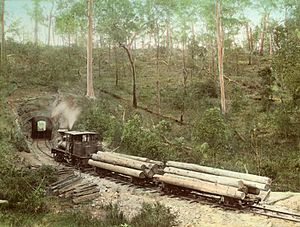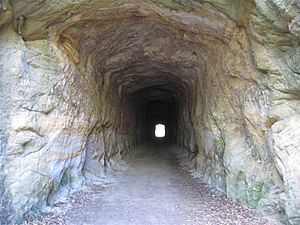Lahey's Canungra Tramway Tunnel facts for kids
Quick facts for kids Lahey's Canungra Tramway Tunnel |
|
|---|---|

Locomotive approaching the tunnel on the Canungra Sawmill tramway, 1912
|
|
| Location | Canungra, Queensland, Australia |
| Design period | 1900 - 1914 (early 20th century) |
| Built | 1901 - 1903 |
| Official name: Lahey's Canungra Tramway Tunnel | |
| Type | state heritage (built) |
| Designated | 11 April 2005 |
| Reference no. | 602529 |
| Significant period | 1900s (fabric) 1903-c. 1933 (historical period of use) 1940s (wartime storage use) |
| Significant components | graffiti, cutting - tramway, tunnel - tramway |
| Builders | Mr Clark |
| Lua error in Module:Location_map at line 420: attempt to index field 'wikibase' (a nil value). | |
The Lahey's Canungra Tramway Tunnel is a special historic tunnel in Canungra, Australia. It was built between 1901 and 1903 by a builder named Mr Clark. This tunnel was part of a large, private tramway system. This system helped transport timber from the forests to the sawmill. The tunnel is now listed on the Queensland Heritage Register because it's an important part of Queensland's history.
Contents
Building the Canungra Tramway Tunnel
The Lahey family came to Australia from Ireland in 1862. They started farming near Brisbane. In 1875, Francis Lahey bought a sawmill for his sons. One of his sons, David Lahey, opened the first sawmill in Canungra in 1884. The family also bought a lot of land around Canungra.
The Growing Timber Business
The sawmill in Canungra did very well for many years. The Lahey family expanded their business. They opened an office in Brisbane and other sawmills in different towns. By the early 1900s, getting timber to the Canungra mill became a problem. The family had bought huge areas of timber land. This meant that slow and expensive bullock teams had to haul logs over very long distances.
A New Way to Transport Timber
The Laheys decided they needed a better way to move timber. They chose to build a tramway into the Pine Creek Valley. This would help keep transportation costs low. The land was very hilly and rugged, which made designing the tramway difficult. They chose a special type of train called a Climax locomotive. This train could handle steep slopes. They also chose a narrow track width to match the government railway lines. They hoped the government line would eventually reach Canungra, which it did in 1914.
Digging the Tunnel
Tom Lahey and Mr Clark chose the tramway route. A civil engineer named George Phillips then surveyed the route in 1900. Mr Clark was hired to start building the tramway. A big challenge was a ridge of the Darlington Range. This ridge separated the mill in Canungra from the timber forests. Instead of building a long, winding route around the ridge, they decided to dig a tunnel through it.
Work on the tunnel started on 1 January 1901. The first train used the tunnel in September 1903. The tramway was designed to make it easier for loaded trains to go to the mill. The downhill slope from the tunnel to the mill was very steep. A safety switch was added to prevent accidents. Luckily, no serious accidents happened, even though there were some "exciting moments" when the rails were slippery.
The Tramway's Use and End
Over time, the tramway grew longer. By 1910, the main line was about 13.5 kilometers long. There were also several branch lines. In total, about 26.5 kilometers of track were laid. The tramway was very busy. In 1915 alone, it hauled about 15,000 tons of logs to the mill.
The tramway also helped preserve some native plants along the tracks. Local people used the tramway for everyday travel. Children even rode it to school, and families used it for picnics. By 1920, most of the timber in the Canungra area had been cut. The mill was eventually closed. The tramway was used for a few more years, with people taking sightseeing trips until 1930. By 1933, the tracks were being removed. The rails were sold for scrap metal in 1935. During its time, the tramway moved a huge amount of timber.
Tunnel's Later Life
During the Second World War, the tunnel was used to store ammunition. This was for the nearby Kokoda Barracks at Canungra. After the war, the tunnel was no longer used. However, it was later cleaned up and officially re-opened for visitors on 21 January 2001. It was later fenced off for safety reasons.
What the Tunnel Looks Like
The tunnel was planned to be about 88 yards long. But it actually measures about 91 meters long. It also has an open cutting at each end. The tunnel is straight and has a rectangular shape. It was cut directly through solid sandstone, so it doesn't need any extra support.
You can see old drawings and names, called graffiti, on the tunnel walls. Most of this graffiti is near the well-lit entrances. Both entrances have steel barriers that were added later for safety. There are also signs that tell the history of the tramway and how the tunnel was used during the Second World War. These modern signs and barriers are not part of the original historical value.
Why the Tunnel is Important
Lahey's Canungra Tramway Tunnel is listed on the Queensland Heritage Register for several reasons:
A Look into Queensland's Past
The tunnel shows how Queensland's history developed. It is a great example of a private tramway system. It also highlights the early timber industry in Queensland.
A Unique Engineering Feat
This tunnel is special because it didn't need any lining or support. This makes it a rare example of a tramway tunnel built in Queensland.
Smart Design and Building
The tunnel shows the clever engineering needed to build railways in tough environments. It represents a high level of technical skill from that time.
Important to the Community
The tunnel is very important to the local community. It is a landmark that reminds people of the early timber industry. This industry helped the Canungra area grow. The tunnel is also a local tourist attraction, showing its social importance.
Connected to the Lahey Family
The tunnel has a strong link to the Lahey family. Several generations of the Laheys were very important in developing the timber industry in Queensland. They also helped the Canungra area grow.


